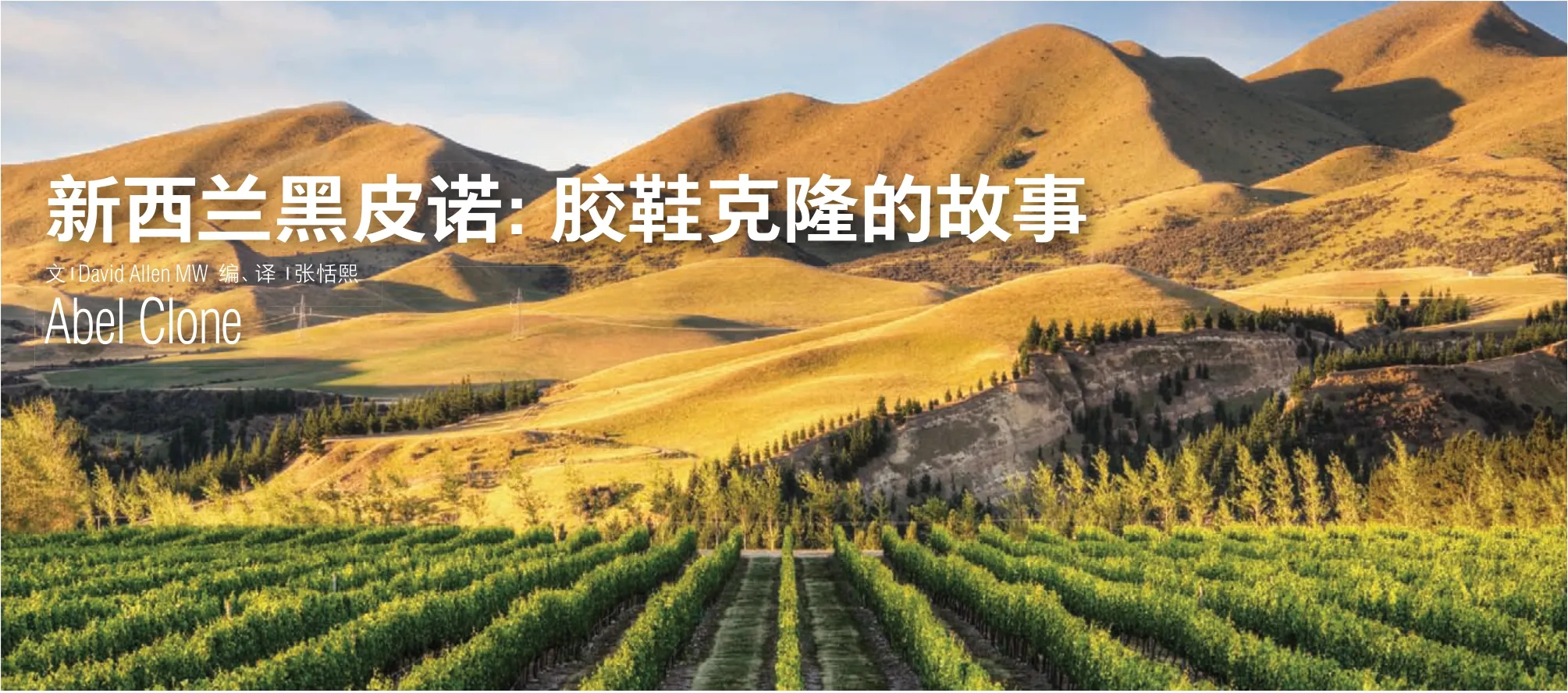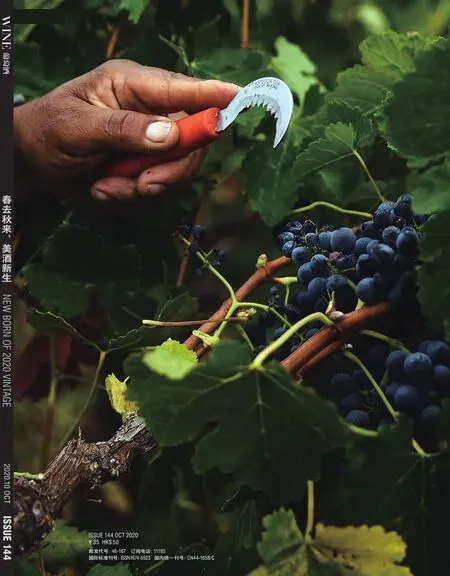新西兰黑皮诺:胶鞋克隆的故事
文 David Allen MW 编、译 张恬熙

我还记得1986年,当我第一次品尝马丁堡酒庄的黑皮诺时,我都被惊呆了!这些年来,我总是会购买这款酒并希望它能够在我的酒窖里陈年,但这个想法从没成功过,因为它真的太美味了,我总能找到喝它的理由。
I remember being wowed when I first tasted 1986 Martinborough Vineyards Pinot Noir. For several years I tried buying this wine to age it, but the bottles never stayed in my cellar as they were always so delicious that I found occasions to drink them.
黑皮诺这个品种是于1889年首次种植在新西兰,但一直到20世纪80年代才通过马丁堡酒庄和新天地酒庄等生产商早期上市的葡萄酒,从而真正树立起其国际声誉。如今,人们可以在新西兰各地找到世界级的黑皮诺。马丁堡、中奥塔哥以及北坎特伯雷供应的黑皮诺葡萄酒最受欢迎,但马尔堡出产的黑皮诺葡萄酒数量众多,而其他类型的黑皮诺葡萄酒则可以在纳尔逊、霍克斯湾甚至奥克兰找到。由于酿酒师能够掌握各自的风土条件,所以新西兰的黑皮诺有各种各样的风格。

来自马丁堡的葡萄酒有独特的深度和丰富的质感,人们通常用泥土味来形容。泥土味更多的是指一种味道而不是质地,这种口感的葡萄酒就如同来自经典的夜圣乔治产区或是玻玛产区的酒款,但它又有天鹅绒般的柔滑质地,更像是来自沃恩h 罗曼尼产区的葡萄酒。
黑皮诺葡萄酒能够拥有如此独特的风格和品质,其中一个原因就是在葡萄园中种植的克隆。马丁堡葡萄酒的风格离不开一个名字很奇怪的克隆品种:“胶鞋克隆(Gumboot Clone)”,又名:阿贝尔品系(Abel Selection)。这种克隆是晚熟品种,而且收成量少,因此它非常适合种植在受到南极寒风影响的地区,寒风会让颗粒大的果实很难成熟,而胶鞋克隆则能够在这样的条件下结出优质的果实。接下来,我们就来说说胶鞋克隆这个丰富多彩的经典新西兰故事。
20世纪70年代,一名从法国返回奥克兰机场的旅客被发现非法携带黑皮诺入境。故事是这样的:他在一双胶鞋里面塞了些葡萄枝。这些被没收的葡萄枝很可能会被作为生物危害品而销毁。幸运的是,发现这一违禁物的海关人员马尔科姆·阿贝尔就是一名来自奥克兰地区库姆小镇的酿酒师。那位旅客表示:这些葡萄枝是从勃艮第神圣的罗曼尼h 康帝特级园摘下来的(这个故事的另外一些版本声称,葡萄枝是来自于拉塔希酒庄)。一天深夜,自己翻过了酒庄的矮墙并偷走了葡萄枝。听完之后,阿贝尔明白了这些走私葡萄枝的重要性,使它们逃过一劫,免于被销毁。在确定这位旅客并不想要留下这些葡萄枝后,阿贝尔花钱让它们在政府的葡萄栽培研究站“Kauwhata”里面进行隔离检疫。隔离期过后,他就把这些葡萄枝种在了自己的葡萄园内。
新天地酒庄的创始人克莱夫h 帕顿在为阿贝尔工作了一年之后,从这些葡萄枝中拿了一些种植在自己位于马丁堡的葡萄园内。新天地酒庄早期获奖的葡萄酒都是只用“胶靴克隆”黑皮诺来酿造的。不幸的是,直到阿贝尔去世之前,他这些做法的意义才显露出来,但阿贝尔葡萄酒公司早已不复存在。他的酒庄变成了一个会议中心,葡萄藤仍然在那里生长,但却不再生产葡萄酒。然而,阿贝尔的遗产仍在新天地酒庄葡萄酒的品质中存在着。尽管其他克隆品种现在也被镀了一层金,但“胶鞋克隆”永远是他们那卓越而独特的黑皮诺的核心。
While the variety was first planted in New Zealand in 1889 it really only started to build its international reputation when these early releases of wines from producers like Martinborough vineyards, and Ata Rangi burst onto the scene in the 1980s.Today it is possible to find world-class Pinot Noirs from all round New Zealand. Martinborough, Central Otago and North Canterbury supply the majority of the most sought after, but numerous wines are made in Marlborough and others being found in the Nelson, Hawkes Bay and even Auckland. New Zealand s Pinot Noirs offer a broad range of styles as winemakers come to grips with their individual terroirs.

Wines from Martinborough display a distinctive depth and richness of texture, often described as earthy. The earthiness is more a flavour than a texture, with the wines being something akin to a classic Nuits-St-Georges or Pommard, yet with a velvety smoothness more like wines from Vosne-Romanée.
One of the factors contributing to the distinctive style and quality of individual Pinot Noir wines is the clone planted in the vineyard. One contributor to the style of Martinborough s wines is the curiously named “Gumboot Clone” (aka the Abel selection). The clone is late-ripening and sets a small crop, making it well-suited to produce excellent fruit in the region where cold Antarctic-winds make it difficult to ripen large crops. The story of the “Gumboot Clone” is a colourful and typically New Zealand tale.
In the 1970s, a traveller returning to Auckland airport from France was caught bringing Pinot Noir into the country illegally in his luggage. The story is that he had stuffed some vine cuttings into one of his gumboots. The confiscated cuttings might have been destroyed as a bio-hazard. Fortunately, the Customs Officer who made the find, Malcolm Abel, was also a winemaker from the Auckland region of Kumeu. The offender explained that the cuttings had been taken from the hallowed Romanée Conti Grand Cru in Burgundy (some versions of this story claim the vineyard was La Tache). Late one night the miscreant had jumped over the domaine s low wall and liberated the cuttings. Understanding the significance of the smuggled cuttings, Abel saved them from destruction. Having established that their liberator had no desire to keep them, he paid for them to be put through quarantine at Te Kauwhata, the government viticulture research station. When the material was released, he planted the vines in his vineyard.
Clive Paton, the founder of Ata Rangi, worked a vintage for Abel and took cuttings with which he planted his own vineyard in Martinborough. Ata Rangi s early, award-winning wines were made solely with “Gumboot Clone” Pinot Noir. Sadly, Malcolm died before the significance of his work became evident and the Abel Wine Company no longer exists, the winery being a conference centre where vines grow, but wine is no longer produced. Abel s legacy, however, lies in the quality of Ata Rangi s wines. Although other clones are now plated as well, “Gumboot Clone” fruit lies at its heart of their superb and distinctive Pinot Noirs.

